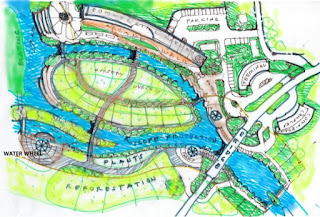Design concepts are produce with paper and pen. No computer can replace what is inside the mind of an architect. This is the initial stage in the practice of architecture. An opportunity to create forms that will make architecture design unique.
The process may be done in different methods by different architects. But the most common is to start somewhere.A thought process that is very important to the architect and record that idea into the paper as the mind dictates the hand in creating a unique design solution to every design requirements. Without boundaries, the architect can pick anything that will inspire him to do the design.
How do architects formulate their design concepts?
This video will tell us how and why.
This is the Design process done by Arhitect Barry Berkus in designing a house. He gives a clear example of his actual design strategies.
The first video will tell us how he observe nature and a crumpled paper to get shapes. By Those methods, he was able to create his own unique syle of architecture.
Truly, this is a great way to understand the design process that is embedded in the mind of an architect. How he thinks and how he respond to the design requirements. The outcome is so amazing and helpful for those pursuing architecture and even those who are running out of ideas in creating the architectural design solutions. More often, the solutions are already right in front of us.
The process may be done in different methods by different architects. But the most common is to start somewhere.A thought process that is very important to the architect and record that idea into the paper as the mind dictates the hand in creating a unique design solution to every design requirements. Without boundaries, the architect can pick anything that will inspire him to do the design.
How do architects formulate their design concepts?
This video will tell us how and why.
This is the Design process done by Arhitect Barry Berkus in designing a house. He gives a clear example of his actual design strategies.
The first video will tell us how he observe nature and a crumpled paper to get shapes. By Those methods, he was able to create his own unique syle of architecture.
Truly, this is a great way to understand the design process that is embedded in the mind of an architect. How he thinks and how he respond to the design requirements. The outcome is so amazing and helpful for those pursuing architecture and even those who are running out of ideas in creating the architectural design solutions. More often, the solutions are already right in front of us.
The video below is the second example on How he get ideas with the information available to him, he began to create a diagram while telling the story on how spaces will be organized. Treating it as if the house is already existing and telling stories on how the end-user will occupy the space. Telling how he will be making those spaces respond to each and the regular activities of his client.
- Whenever you are confronted with a design problem, be analytic and observant. There must be a information available in the environment you are into.
- Design process must always tell a story.
- A story must have an inspiration that will influence the outward appearance of the house and the the space functionality needed by the client.
- Architecture may influence the way people interact with the spaces or it can also influence the way people will live within the pattern of influence created by the architect.
- Design process is a continuous development of the space required in relation to the functionality of the spaces provided for the client.









